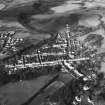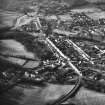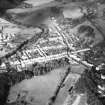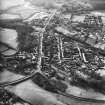Gatehouse Of Fleet, Ann Street, Scott's Cotton Mill
Cotton Mill (18th Century), Saw Mill (18th Century)
Site Name Gatehouse Of Fleet, Ann Street, Scott's Cotton Mill
Classification Cotton Mill (18th Century), Saw Mill (18th Century)
Alternative Name(s) Sawmill; Mill House
Canmore ID 64034
Site Number NX65NW 21
NGR NX 60325 56378
Datum OSGB36 - NGR
Permalink http://canmore.org.uk/site/64034
- Council Dumfries And Galloway
- Parish Girthon
- Former Region Dumfries And Galloway
- Former District Stewartry
- Former County Kirkcudbrightshire
NX65NW 21 60325 56378
Mill House [NAT]
OS (GIS) MasterMap, August 2009.
(Location cited as NX 603 564). Cotton mill, built c. 1790 by Thomas Scott & Co. A 3-storey, 6-bay rubble building, the best preserved cotton mill in Galloway, now a sawmill.
J R Hume 1976.
Latterly used as sawmill.
I Donnachie 1971; W Minchinton 1984.
This building is noted as Mill House on current Ordnance Survey GIS vector map.
Information from RCAHMS (LKFJ), March 2002.
What has evidently been a mill lade is indicated immediately to the E of this building.
Information from RCAHMS (RJCM), August 2009.
Publication Account (1986)
With its bright colour-washed buildings, wide streets and hilly tree-clad setting, there could scarcely be a less industrial image than that presented by Gatehouse of Fleet. Yet, for a few decades, this trim little town was the centre of the cotton textile industry in Galloway and stood close to the forefront of the industrial revolution in Scotland. It is this contrast that makes Gatehouse of Fleet such a worth while subject for archaeological rediscovery.
In 1785 James Murray of Broughton and Cally, founder of Gatehouse, granted a lease on the banks of the River Fleet in his recently established village to Messrs Birtwhistle and Sons, a Yorkshire firm of cattle dealers and merchants, who had been thwarted in their initial attempts to build a cotton mill near Kirkcudbright. They built two water-powered mills; a third mill in the same complex was added by a Mr McWilliam, and a fourth was established at the north-eastern end of the village by the Ulster firm of Thomas Scott and Company. Altogether, these spinning and weaving mills employed a workforce of more than 500, and required the services of a brass foundry to maintain the metal parts of their machinery in running order. By the 1790s the centre of Gatehouse also contained two tanneries, a soapwork (by-products of the cattle trade), and a brewery. As a source of power the Fleet was inadequate, and an elaborate water-course, 6.4km long, was engineered to draw 'copious streams of water' to two dams at the head of the village. But the river was useful as a means of transport, and to improve access a 1.3km-long reach between Gatehouse and Skyreburn Bay was canalised in 1824-5. Thanks to David McAdam, a local merchant and shipowner, the shallow landing-place at Boat Green (NX 598560) was replaced in 1836-7 by a new quay at the head of the canal, usable by ships of 300 tons and ever since known as Port McAdam.
By this date, however, the textile industries of Gatehouse had lost their impetus, having been unable to compete with steam-powered and better transport related mills elsewhere. After Murray's death in 1799 Scott's mill closed, later to be converted into an estate sawmill. The Birtwhistle mills were idle between 1810 and 1832, at which date they were acquired by Messrs James Davidson and Company. Having quickly rebuilt a mill gutted by fire in 1840, this company fought valiantly to remain in business, but survived only until about 1850. Their mills subsequently came into the possession of a firm of timber merchants, who converted one of the buildings into a bobbin mill. Pirns and bobbins were manufactured here until the early 1930s; by that decade the sawmill and barracks that had been Scott's mill had probably become a private house, the main brewery had closed (in 1911), and Port McAdam was being used commercially for the last time.
The best-preserved of the early cotton mills is the three-storeyed building at the head of Ann Street (NX 603563) that began life as Scott's mill. Of the Birtwhistle complex there is the ivy-clad (and dangerous) ruin ofa four-storeyed mill (NX 599563) and the overgrown foundations of two others, the positions of the large water-wheels still being discernible. The activities of this fIrm are now best represented by terraced rows of single- and two-storeyed workers' houses in Birtwhistle Street (NX 601566) and Catherine Street (NX 600565). Other survivors from Gatehouse's industrial heyday include the former brewery (NX 599563), a sizeable three-storeyed and hip-roofed block which stands above the Fleet Bridge; on the opposite side of the High Street, below the Angel Hotel, is the building which used to be the main tannery (NX 599562). The remains of the water-power system are worthy of exploration, and the straight line of the Fleet Canal still presents itself very obviously to view. The remains of the drystone, timber-fronted quay at Port McAdam were repaired in 1975 for use by pleasure craft, one facet of Gatehouse's best-ever industry-tourism and leisure.
Information from ‘Exploring Scotland’s Heritage: Dumfries and Galloway’, (1986).
































